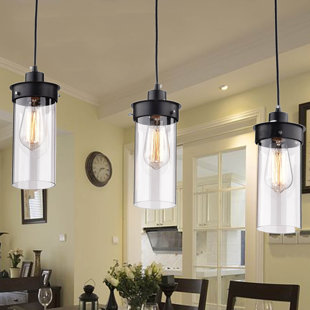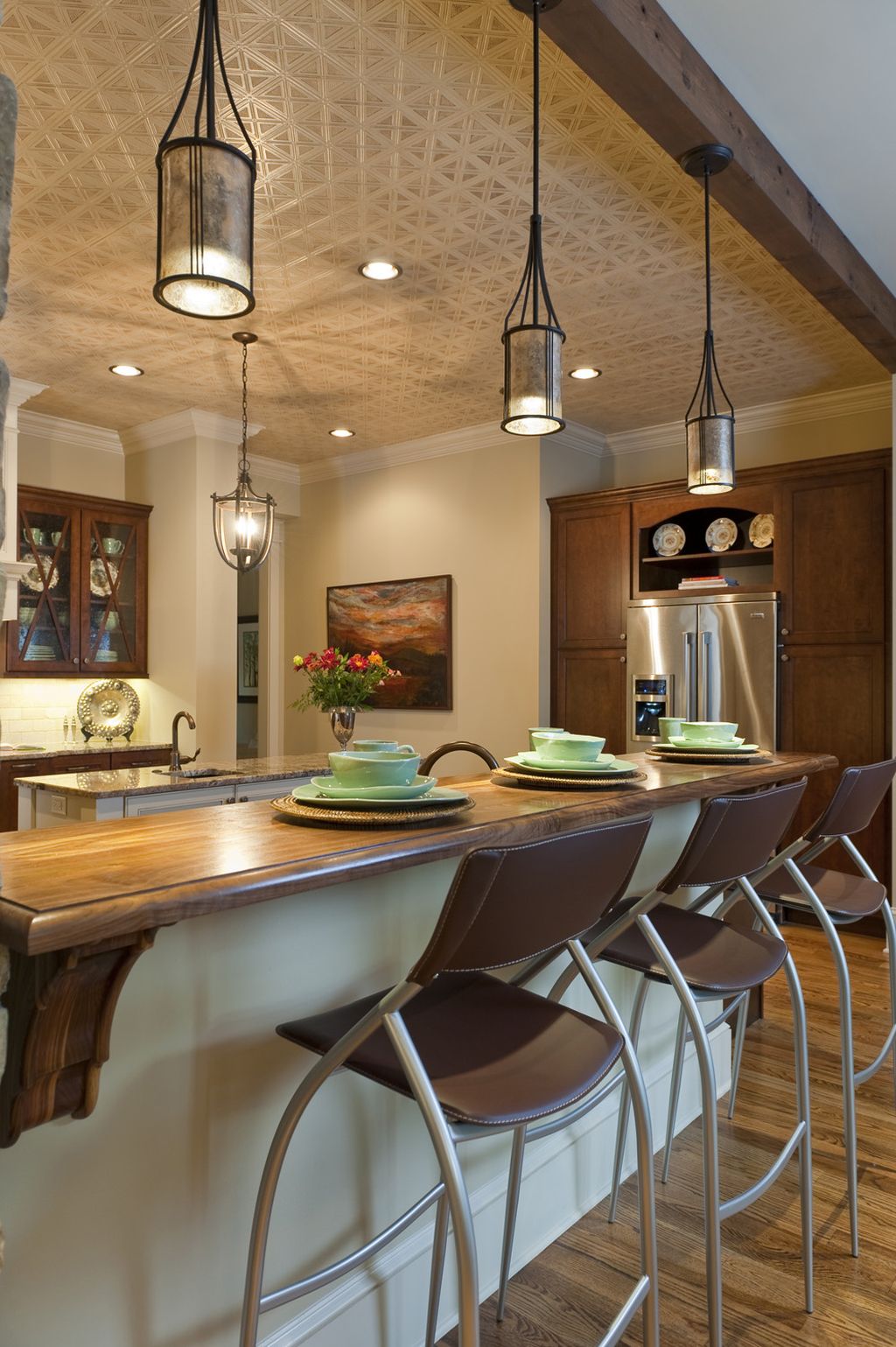Pendant lights over a kitchen island are an essential element in creating a well-designed, functional, and inviting kitchen space. Not only do they provide targeted lighting that enhances visibility for food prep and other activities, but they also bring style and personality to the kitchen. Kitchen island pendant lights come in a wide array of styles, materials, and shapes, allowing you to tailor your lighting choices to the overall design of your kitchen.
From sleek, modern fixtures to rustic or industrial designs, pendant lights can reflect and enhance your kitchen’s decor. The ability to select multiple pendants, vary their height, and choose the bulb type adds even more flexibility, making pendant lighting one of the most versatile choices for illuminating a kitchen island.

Choosing the right pendant light size is crucial for both aesthetics and functionality. The size of the pendants should be proportionate to the kitchen island. Small islands may look better with two or three smaller pendants, while larger islands can handle bigger or multiple lights. Oversized pendants create a bold look and can serve as focal points, while smaller, more understated pendants offer subtle elegance without overwhelming the space. It’s also important to consider the height of your ceiling, as pendant lights need to be installed at a height that allows ample headroom while still providing sufficient illumination.
Spacing the pendant lights correctly is another key consideration for a balanced look. Generally, pendants should be spaced evenly over the island for consistent lighting and aesthetic harmony. A common rule of thumb is to place pendants 24 to 30 inches apart, although this can vary based on the size of the fixtures and the length of the island. The height at which you hang your pendant lights also matters, as they should not obstruct views across the kitchen or impede movement around the island. Hanging pendants 30 to 36 inches above the countertop is typically ideal, though adjustments can be made based on personal preference and kitchen layout.

The type of light bulb you choose for your kitchen island pendant lights has a significant impact on the mood and functionality of the space. Bright, cool-toned bulbs are excellent for tasks, as they improve visibility for chopping, measuring, and cooking. Warm-toned bulbs, on the other hand, create a cozy, welcoming atmosphere, which is especially nice if your kitchen island doubles as a dining area. LED bulbs are a popular choice due to their energy efficiency and long lifespan, and they come in a variety of color temperatures. Dimmable bulbs offer even more versatility, allowing you to adjust the lighting intensity based on the time of day or the activity at hand.
In terms of materials, kitchen island pendant lights come in an extensive range of options, from metal and glass to wood and fabric. Metal pendant lights, such as those made of brass, copper, or iron, are popular for their durability and sleek appearance. Glass pendants, particularly clear or frosted glass, offer a timeless look that complements most kitchen styles and provides a soft, even light. Wood pendants add warmth and a natural element to the kitchen, making them an excellent choice for rustic or farmhouse-style spaces. Fabric shades, though less common, can bring a unique texture and softness to the kitchen, creating a more intimate, cozy vibe.

Pendant lights are available in a variety of shapes and styles, each contributing to the aesthetic of your kitchen in different ways. Dome-shaped pendants, for example, provide directed light and work well over task areas, while globe pendants give off a more diffused light that softens the space. Drum pendants offer a clean, modern look with more diffused lighting, which can work well for larger islands. For a touch of elegance and sophistication, chandeliers or multi-light pendants can serve as a statement piece over the island. Industrial-style pendants, often made of metal with exposed bulbs, are perfect for adding a touch of urban charm, while minimalist pendants suit contemporary spaces.
Color and finish are important considerations when selecting pendant lights, as they should harmonize with the kitchen’s palette and finishes. A polished chrome or stainless steel pendant, for instance, pairs well with modern stainless appliances, while warm brass or gold finishes can add a pop of warmth to a neutral kitchen. Black or dark-colored pendants are striking in a light kitchen, creating contrast and adding depth. If you prefer a more subtle approach, neutral colors like white, beige, or even clear glass can complement various decor styles without overwhelming the space.
One of the most exciting aspects of choosing kitchen island pendant lights is the option for unique or custom designs. Statement pendants with intricate designs, colored glass, or unusual shapes can serve as artwork in the kitchen, adding personality and flair. Sculptural pendants or those with mixed materials like wood and metal create visual interest and can become conversation pieces. Custom or artisanal pendants can elevate the space, reflecting a refined and personal touch. Investing in a statement pendant light can completely transform the look and feel of a kitchen, turning a functional lighting solution into an eye-catching centerpiece.

Installation of kitchen island pendant lights should be done with careful planning. It’s ideal to work with a qualified electrician to ensure the wiring and placement are correct. When planning the installation, think about the amount of natural light in your kitchen. If your kitchen has ample natural light during the day, you might not need as many pendant lights or may prefer adjustable fixtures that provide softer evening lighting. Additionally, pendant lights that complement under-cabinet lighting can help create a layered lighting design, enhancing both the functionality and ambiance of the kitchen.
While pendant lights over the kitchen island are primarily functional, they can also help define the kitchen’s layout. In open-concept spaces, pendant lights act as a visual boundary, separating the kitchen area from adjacent dining or living spaces without the need for walls. The lighting delineates the island as a focal point, providing a sense of structure and intimacy within a larger room. Pendants that coordinate with lighting in other areas, like the dining room or living room, can create a cohesive look that ties together the different spaces in an open floor plan.
Pendant lights can also influence how we perceive space within the kitchen. In smaller kitchens, a carefully chosen pendant can make the area feel larger by drawing the eye upward. Selecting pendants that don’t obstruct views or are visually light, such as clear glass pendants, can help maintain a sense of openness. In larger kitchens, oversized pendants or multi-light configurations add presence and can fill the space proportionately, making the kitchen feel complete and well-balanced.

Maintenance for kitchen island pendant lights is straightforward but essential. Glass or metal pendants can accumulate dust and grease, especially in a kitchen environment, so regular cleaning helps maintain their appearance and light output. Glass shades can be washed with a mild soap solution, while metal can often be wiped down with a damp cloth. For fixtures with intricate designs or delicate materials, follow the manufacturer’s cleaning recommendations to avoid damage. Keeping the lights clean not only enhances their aesthetic but also ensures maximum brightness and effectiveness.
Pendant lighting is also ideal for creating layers of light within a kitchen. Combining pendant lights with other types of lighting, such as recessed lights and under-cabinet lights, helps reduce shadows and ensures the entire kitchen is well-lit. The pendant lights over the island provide task lighting for meal prep, while other light sources can add general or ambient lighting to the rest of the kitchen. By layering light, you can create a versatile, functional space that adapts to different needs, from cooking to entertaining.
Finally, smart home technology has expanded the possibilities for pendant lighting. Many modern pendants are compatible with smart bulbs, allowing you to control brightness, color, and timing from your phone or through voice commands. This flexibility is particularly useful for creating different moods throughout the day, whether you want bright light for cooking or a softer, warmer light for evening gatherings. Smart dimmers or smart bulbs with adjustable colors can enhance the versatility of your kitchen island lighting, making it easy to adapt the lighting to any activity or occasion.

Common Mistakes to Avoid
One common mistake when selecting kitchen island pendant lights is choosing fixtures that are too large or too small for the island, which can throw off the balance of the room. Another mistake is neglecting the ceiling height, as pendants hung too low or too high can either obstruct views or fail to provide adequate lighting.
Using the wrong type of bulb, such as one that’s too dim or overly bright, is another frequent error that affects functionality. Some people also skip installing dimmer switches, which limits the flexibility of the lighting. Lastly, failing to consider the kitchen’s natural light can lead to over-lighting or under-lighting the space.

How high should I hang the kitchen island pendant lights?
I recommend hanging pendant lights 30 to 36 inches above the island surface for optimal lighting and headroom. This height provides adequate task lighting while keeping the fixtures from obstructing your view across the kitchen.
What size pendant lights should I choose for my kitchen island?
The size depends on the island’s length and the number of pendants you plan to use. For a balanced look, select pendants that are proportionate to the island’s size. Generally, pendants with a diameter of 10-12 inches work well for smaller islands, while larger islands can handle wider pendants or multiple lights.
How many pendant lights should I install over my kitchen island?
For most islands, two to three pendant lights provide adequate lighting and balance. Space them evenly along the island, about 24-30 inches apart. The number can vary based on the island’s length, the pendants’ size, and personal preference.

Can I use LED bulbs in my pendant lights?
Yes, LED bulbs are a great choice for kitchen pendant lights as they are energy-efficient and long-lasting. Many LED bulbs are also dimmable, allowing you to adjust the brightness as needed for different tasks or moods in the kitchen.
What type of material is best for kitchen pendant lights?
The best material depends on your kitchen style and maintenance preferences. Metal and glass are popular for their durability and ease of cleaning. Wood or fabric shades add warmth and texture but may require more upkeep, especially in a busy kitchen environment.
How do I choose the right style of pendant lights for my kitchen?
Consider your kitchen’s overall design theme and color scheme. Modern kitchens benefit from minimalist or industrial-style pendants, while rustic or farmhouse kitchens look great with wooden or vintage-inspired fixtures.

Related Posts:
- Affordable Kitchen Lighting
- Battery Operated Kitchen Cabinet Lights
- Open Plan Kitchen Lighting
- How To Install Can Lights In Kitchen
- Small Hanging Lights For Kitchen
- Kitchen Island Lights Houzz
- Kitchen Lights Ideas South Africa
- Kitchen Floor Lighting Ideas
- Victorian Kitchen Lighting Ideas
- Globe Kitchen Pendant Light